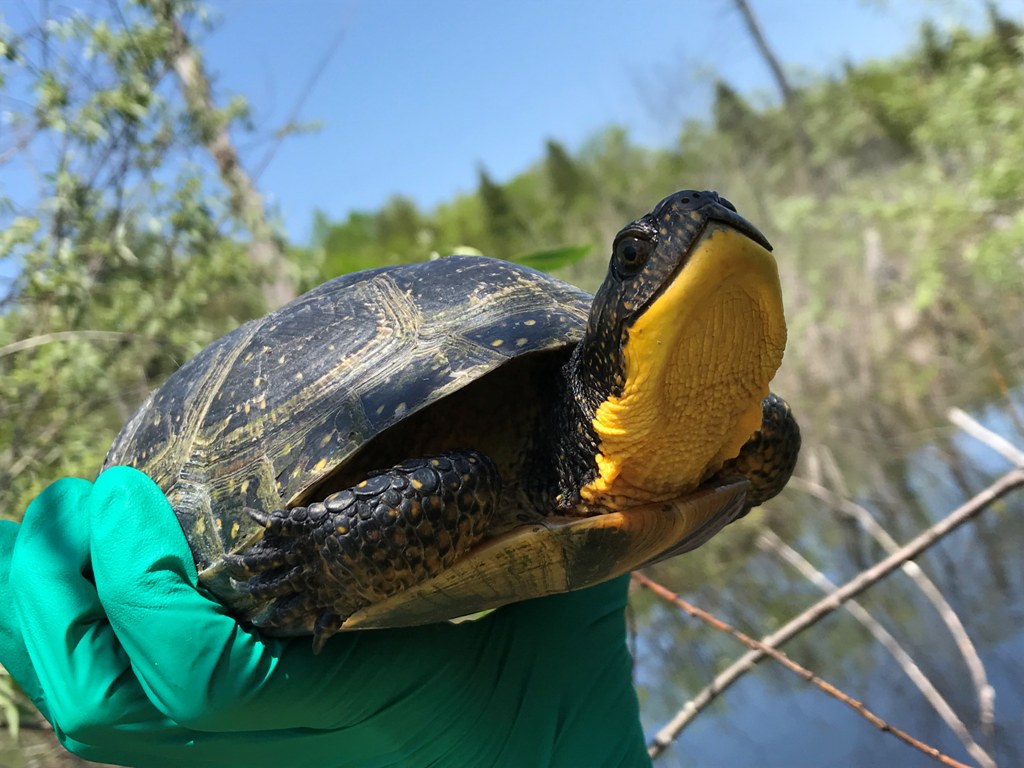Hello all! As many of you know the field team is out and about tracking juvenile head-started, wild, and translocated Blanding’s turtles, via radio telemetry. We started off the 2020 season tracking 19 turtles and currently we are up to 25 individuals!
This season we found a turtle that was lost in 2017, likely because it moved out of range of the equipment. After 3 years, this little turtle is back in the study, and is very stealthy at avoiding us while tracking! A wild juvenile has also been found and added to the study, wild juveniles are not often seen due to the dense habitats they live within, but luckily this little one was having a walk across shrub roots and was spotted while we were tracking one of our head-starts.

Wild juvenile 370, climbing over shrub roots.
Additionally, we released 4 head-started juveniles that were hatched in 2015. Upon release they explored the various species of aquatic vegetation around them and enjoyed the nice cool substrate. They are becoming more familiar with their surroundings each day and one individual has even put on some pounds, finding a variety of tasty snacks in the wetland!

One of the newly released head-starts, surveying its surroundings.
The two translocated turtles we track, 032 and 034 are often switching wetland locations, and during one of our tracking events we discovered that they had swapped wetlands. 032 traveled 1.5 km to get to 034’s wetland and 034 had left and traveled 1.5 km to get to where 032 had just came from…… in other words they keep us busy.

Turtle 034.
Apart from the turtles we’re tracking, we capture and process any incidental turtles we come across. The old myth that turtles are slow, just is not true. They are so speedy, and capturing them often involves becoming drenched and covered in aquatic vegetation, but being very happy to have captured the turtle! Once turtles are captured, they are given a unique identification code that is filed into the marginal scutes (edge scutes) of their shell. This allows us to determine if the individuals have been captured in previous years, and to collect more data on that individual turtle. This season we had a recaptured female Blanding’s turtle that was gravid (carrying eggs), which was very exciting! Below is a summary of our capture success so far:
| Species | Number Captured | Number Recaptured from Previous Years |
|---|---|---|
| Blanding’s Turtle | 14 | 10 |
| Painted Turtle | 7 | 0 |
| Musk Turtle | 12 | 1 |
| Snapping Turtle | 2 | 1 |

A recaptured female Blanding’s turtle, that was gravid!
While in the field we are immersed in nature and have the pleasure to see a variety of species whether they are plants: pink lady slipper, rose pogonia, cotton grass spp., rattlesnake fern; insects: swallow tail butterfly, monarch butterfly; amphibians: mink frog, wood frog, gray treefrog; additional reptiles: smooth green snake, eastern milksnake, five-lined skink; birds: summer tanager, black-billed cuckoo, sandhill crane; mammals: North American river otter, white-tailed deer and moose.

Pink lady slipper.

Northern watersnake.

North American river otter.
We’re having a great season so far, and we hope that there will be a lot more to share upon the commencement of the season!






